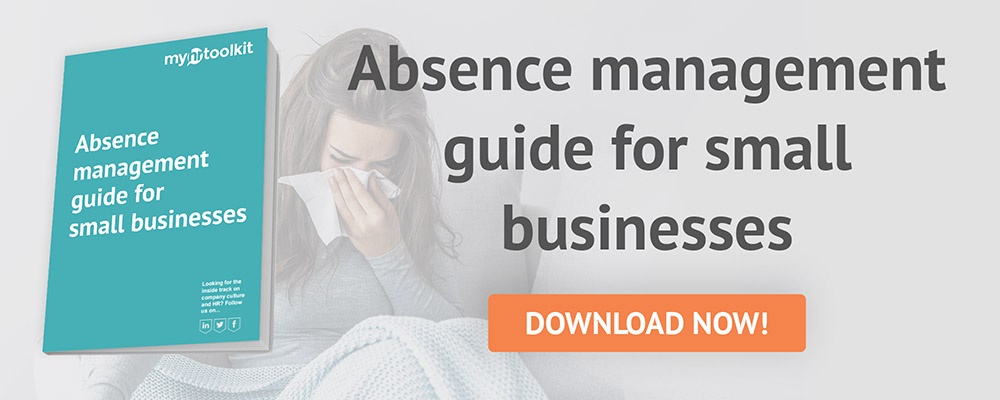Managing employee sickness absence is something many employers find challenging and, it's true, it can be one of the trickier aspects to navigate when it comes to people management. This article considers what short and long-term sickness absence is, how employers should go about managing both, and key areas to be aware of.
What is short-term and long-term sickness absence?
To be honest, the clue is in the title: short-term absence tends to be absence from work for short periods of time which can be anything from one day up to a month in duration. Long-term absence is anything over a month in duration. Both types of absence can have an impact on any business and, as such, need to be managed in an effective yet empathetic manner.

How do you manage absence?
A vital element of absence management is around timely intervention. All too often an employer will back off from actively managing sickness absence, and this can make things more difficult in the long run. Therefore, it is important to act quickly and keep on top of employee absences. However, the management of short and long-term absence if often quite different. Let’s look at each in more detail:
Managing short-term absence
Arguably, this is where the biggest impact can be made if handled well.
Firstly, employers need to have a clear sickness absence management policy and procedure which sets out how short-term absence will be managed, including any expectations of employees by the employer. Typically, this will include the following:
- Certification requirements – This relates to what certification employees should provide to cover their absence. Usually, self-certification is fine up to 7 days and then for absences over 7 days, a medical certificate is required – known as a 'Fit Note', which can be provided by a GP, Nurse, Occupational Therapist, Pharmacist, or Physiotherapist.
- Notification requirements – What must your employees do when they are unable to attend work due to ill health? Who do they inform and how? What time are they required to do this by? What information are they expected to share?
- Return to work meetings – These are often a key component of successful absence management, but sadly, they are often neglected. After all, Sam in accounts, for example, has only been off for a day so what’s the point of holding a return-to-work meeting? Well, the point is, if Sam has a lot of one-day absences, the impact on the business and their work can be detrimental and these meetings are a way of asking the employee to account for their absence in a structured and supportive way and will typically cover:
- The reasons for the absence
- Whether there is an underlying health issue causing absence
- Ensuring the employee is ok to return to work
- Any support required from the manager
- Any issues the manager needs to be made aware of
- Any relevant updates/anything the employee has missed whilst absent
- Trigger points – Most sickness absence management policies state how the employer will measure short-term absence in terms of what it considers to be acceptable/unacceptable and the potential action they may take in the case of unacceptable levels. There are different ways of doing this, for example;
- Bradford Factor (BF) – This is based on the theory that short-term bursts of absence have a more negative impact on a business than longer ones. The Bradford Factor ‘weights’ absence in terms of frequency and duration – the BF is then calculated by multiplying the number of instances by the total number of days off work. The employer will then determine what constitutes a good/bad BF score based on their own business and the types of action the employee may face depending on their score.
- Absence Instances – This considers the number of instances of absence over a period of time and the employer will set out what they consider to be an acceptable or unacceptable number of absences over, say, a 6 or 12-month timespan. Again, it is up to individual employers to set out what will be considered an acceptable number of absence instances and the potential escalation of action the employee may face.

- Payment during sickness absence – There is no legal requirement to pay an employee their usual pay when they are off sick, although Statutory Sick Pay (SSP) must be paid in line with qualification periods. Many employers pay salary for sickness absence, often known as Company Sick Pay (CSP), and this can range from 5 days’ pay to months of pay for sickness absence. Any policy needs to clearly state the conditions which need to be met for CSP to be paid and be clear about the instances when it may be withheld.
- Occupational Health Referrals – These should not just be reserved for the management of longer-term sickness absence. Occupational Health referrals can be extremely useful to help manage short-term absence in certain circumstances, and absence management policies should clearly outline when and why they may be used.
Managing long-term sickness absence
Whilst managing short-term absence is often about early intervention and improvement, managing long-term absence is somewhat different in that, by its very nature, an employee is unable to improve through intervention.
Long-term sickness absence reasons can vary from serious illness, injury from an accident, or due to terminal illnesses such as some cancers. It also covers absences due to major operations and mental illness. When it comes to management of these types of absences, the approach is often more nuanced with a focus on what can be done to get the employee (safely) back to work – so more about what they might be capable of rather than incapability. Of course, this must be managed very closely with the appropriate medical professionals and via discussion and consultation with the employee. Getting professional medical advice is essential in cases of long-term sickness absence, as is establishing a pattern of regular contact with the employee, However, this should be discussed and agreed depending on the nature of the illness.
Sickness absence - what laws should employers be aware of?
The Equality Act 2010
This protects individuals from all types of discrimination in the workplace. It is relevant to health, as any condition which has a long-term adverse effect on an individual’s ability to carry out day-to-day activities is likely to be classed as a disability and therefore will be a protected characteristic requiring an employer to make reasonable adjustments to the individual’s employment and absence related to the condition. For example, if an employee suffers with a long-term health condition which means they have to take more frequent sick leave, a reasonable adjustment may be to discount sickness absence relating to the condition when making decisions about possible disciplinary action or withholding company sick pay. The reasonable adjustment effectively removes the barrier created by the long-term issue and puts the employee on a level playing field with other employees who have no ‘disability’ or protected characteristic.
The Health and Safety at Work Act 1974
This makes employers take responsibility for the health and safety of their colleagues whilst at work and is also known as a 'duty of care'. This covers areas such as carrying out risk assessments to ensure the employee is fit and able to return and there are no obvious risks associated with this. It can also cover the requirement to make reasonable adjustments and capability in that they may be willing to return but not safe to do so.
Ultimately, sickness absence can be difficult to manage but it is important to have a clear Absence Management policy in order to set out an employer’s approach to managing absence. Then, it is essential that the policy and procedure are followed, with clarity around expectations of the employee. Furthermore, using the right HR Software can make a huge difference and simplify absence management for you, allowing you to monitor absences, calculate sick pay, create reports, and much more.
Read more from the myhrtoolkit blog

Written by Kate Marchant
Kate Marchant is an experienced HR professional and CIPD Associate Member who offers straight talking HR solutions for SMEs with friendly and jargon free advice through her consultancy Running HR Ltd.


 Holiday Planner
Holiday Planner Absence Management
Absence Management Performance Management
Performance Management Staff Management
Staff Management Document Management
Document Management Reporting
Reporting Health and Safety Management
Health and Safety Management Task Management
Task Management Security Centre
Security Centre Self Service
Self Service Mobile
Mobile-Oct-10-2022-02-26-04-33-PM.png)



